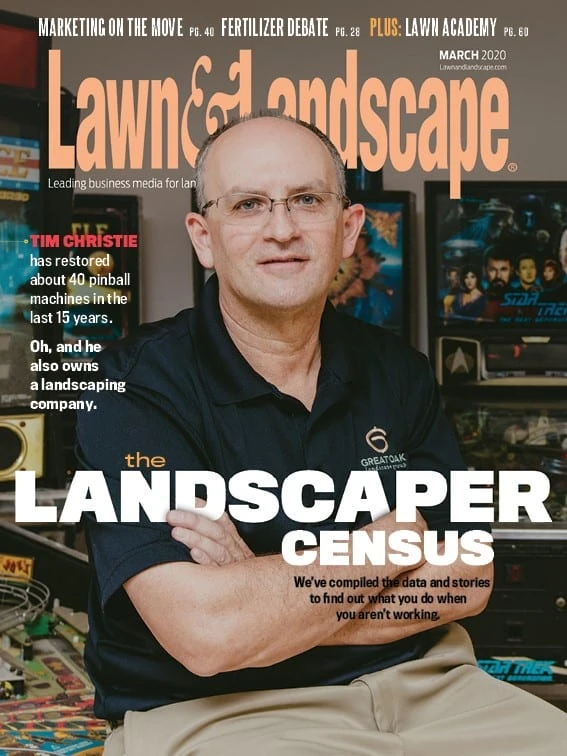Travels with Jim follows Jim Huston around the country as he visits with landscapers and helps them understand their numbers to make smarter decisions.
Will Smith starred in the 2006 film “The Pursuit of Happyness.” The film is a true story about Chris Gardener’s one-year journey being homeless and his subsequent rise to being a very successful stockbroker. The Declaration of Independence provides three examples of “unalienable rights.” They are life, liberty and the pursuit of happiness. Unalienable means that they cannot be taken away or denied.

The word happiness seemed very superficial to me until I recently learned that, to the Framers of our Constitution and Founders of our country, it was a synonym for flourishing. Webster’s Dictionary defines flourish(ing) quite well: “to blossom … to grow vigorously; succeed; thrive; prosper … to be at the peak of development, activity, influence, production … to be in one’s prime.” More on this later.
In my most recently published book, “Benchmarks for Landscape Construction Professionals,” I cataloged benchmarks from my 34-year career in the green industry. I started collecting this data us in the late 1980s. These benchmarks I refer to as objective, quantifiable benchmarks. There are hundreds of them and a calculator is used to determine them.
The most important ones I refer to as critical numbers. Critical numbers are similar to vital signs for the human body. Both are indicators of the health of the entity from which they are derived.
Not all benchmarks and/or critical numbers are analytical and quantifiable. There are also intuitive standards. They are just as real – I’d argue more so – as the more quantifiable ones. Quantifiable standards you learn and know by using a calculator and arithmetic. Intuitive ones you know by direct experience. For instance, you don’t need a calculator to know if you are happy or not. You know if you are happy or anxious through direct experience. You don’t have to “run the numbers” to determine if you are enjoying your career. You may be able to reduce your stress level to some kind of measuring system, but you probably know that you are stressed out long before you see a report telling you so.
How it works in the field.
A client of 10 years and in mid-career just had his best year ever. Sales topped $7 million and his net profit was well over 20%. His family was doing great and life in general was fantastic! However, he was maxed out. Things had to change because he knew that he couldn’t keep up the hectic pace much longer.
Another client of over 30 years is currently near the end of his career. Health issues combined with the stress of running a large landscape company have taken its toll. Life just isn’t fun or fulfilling anymore. Fortunately, this individual has a great wife and support team. Otherwise, I’d be very worried about him.
Calibrating your happ“y”ness meter.
Flourishing is an interesting concept. It’s easy for us to see what is necessary for a garden to flourish – proper care, water, the right temperatures, fertilizers, etc. It’s more difficult for us to figure out what is necessary for a human being to flourish. You may have seen the bumper sticker, “He who dies with the most toys, wins!” Flourishing is much deeper than that. Just like a garden that flourishes, flourishing of the human spirit encompasses all that you are and all that you do. It includes all aspects of your life: the physical, intellectual, mental, spiritual, social, vocational, financial, etc. Not only do you want your business to flourish, but you also want yourself, your family and your employees to flourish.
In order for you to address the concept of personal flourishing, you first have to identify some sort of standard (or standards) to which to compare and measure yourself. It may seem difficult but it’s not impossible. For instance, on a scale of one to 10 (with one being the least amount and 10 the most) how stressful is your life currently. Give yourself a one if you hop-and-skip through the day whistling the song, “On The Good Ship Lollipop.” Rate yourself with a nine or ten if you’re about to lose it.
Conclusion.
Benchmarks can be valuable standards by which we measure the health of your business. They are the objective, analytical standards that we compare your business data to (often using your profit and loss statement), and a calculator. Medical vital signs are the key benchmarks that doctors compare data from one’s body to in order to indicate one’s physical health. Taking this one step further, we use personal intuitive benchmarks for comparison purposes to help us measure the degree to which we are flourishing. I like to refer this as calibrating your happ“y”ness meter. I will explain how to calibrate your happ“y”ness meter next time.

Explore the March 2020 Issue
Check out more from this issue and find your next story to read.
Latest from Lawn & Landscape
- Ceramica acquires Fundraising Brick
- Senske Family of Companies acquires Huron Pest Control
- Sunseeker unveils new X7 Series Robotic Mowers
- Bobcat Company debuts MT120 mini track loader
- Senske Family of Companies opens new corporate office
- Autonomowus Lawn Company adds robotic mowers to Genan tire recycling plant
- Visterra Landscape Group acquires Cleveland-based H&M Landscaping
- SiteOne names Carrothers VP of agronomic business development





